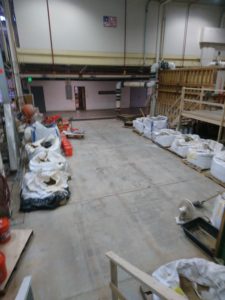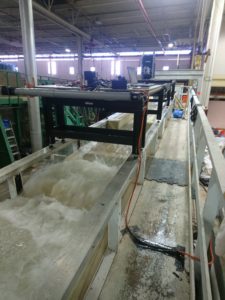Hello! My name is Rider Johnson and I attend Telluride High School. My internship is with the USBR (United States Bureau of Reclamation) at the Denver Federal Center in Lakewood, Colorado. The Bureau of Reclamation controls all of the water in the American West. I drove up to Denver on Tuesday the 4th and stayed with some family before going to my lovely host family. That Friday I was brought to my host family who lives in Golden. We spent the weekend hiking, playing board games, and figuring out how I would get to work every day.
My internship started that Monday. I ultimately decided to ride the train to and from work every day. That Monday I woke up and rode the train to work and ended up arriving about 30 minutes early. Work started at 8:00 AM and I got there at 7:30. It was nice, though, because my mentor also came early and I got to meet him and he gave me a tour of the hydraulics lab. The hydraulics lab is a super cool huge building that has all these models set up for testing in them. I spent my first day reading more about hydraulics and getting some more logistics done.
Over the next few days, I got to help an engineer who was with the Army Corps of Engineers with some of the testing she was doing. The Corps of Engineers and the Bureau of Reclamation were working together on this project to find the rate at which different mixtures of sand and rock erode at different flow rates and slopes.
Each one of the white bags had some type of rock, sand or gravel in it. Basically, I got a sheet of paper that told me which material to get and how much of it, then put it in a bucket. After gathering all of the correct amounts for the mixture you would put it in a mixer and add some water until it was more like concrete. Next, they would pack into a section on a medium-sized flume machine, then set the flume machine to a certain angle. The tests I helped to perform had the machine set at an 8% slope. Next, we chose the flow rate. The medium flume machine could only do about five cfs (cubic feet per second) before overflowing. The tests I saw had a flow rate set to five and three cfs. Then they would open the valve so that water could enter the flume.
This picture shows the flume machine with water running down it. It’s hard to see, but one of the black objects above what looks like a table actually moved around the mixture. This device had two lidar beams that went down and measured the distance to the top of the water and to the top of the mixture. As the mixture began to erode, due to the water pressure, the distance to the top of the mixture increased. This machine ran at 8000 kilohertz, meaning it was able to take 8000 points of data every second. These points were displayed on a graph on a computer.
The reason they were doing this testing was because of dams. There are two types of dams: concrete and those made of natural materials. The dams made of natural material are cheaper to make than concrete dams. However, natural dams can erode under moving water. Therefore, this testing helps engineers around the US working on these natural dams approximate how much will erode during a flood. However, if it’s supposed to flood over the top of the dam for only two hours they won’t really worry too much because it won’t erode too badly, but if it’s going to be flooding for days it can cause the whole dam to erode down. Knowing this gives them time to warn any people downstream of more flooding and people can evacuate. That was what I spent most of my week observing, and helping out in a more hands-on way when I could.
This weekend I went on some more hikes and walked around downtown Golden. I don’t know what I’ll be doing next week, but whatever it is I’m sure it will be interesting and I’m excited about it!



There are no comments published yet.